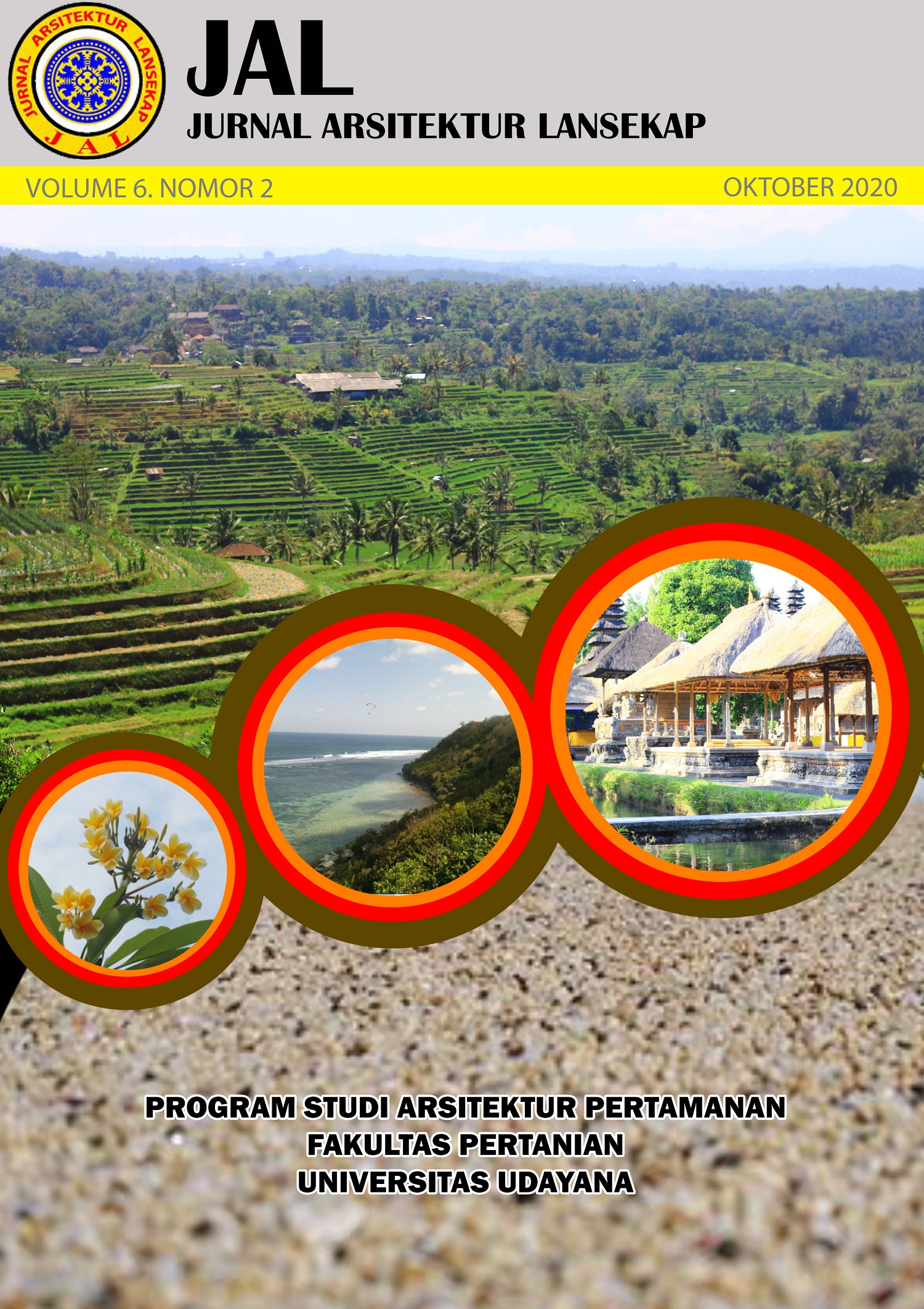Identifikasi lanskap Karang Bengang di Desa Buahan, Kecamatan Tabanan, Kabupaten Tabanan
Abstract
Landscape identification of karang bengang at Buahan Village, Tabanan Subdistrict, Tabanan Regency. This research is motivated by the absence of the spatial pattern of landscape character of karang bengang at Buahan Village. Karang bengang is an open space that is located between the villages as a nonresidential area. The existence of karang bengang increasingly rare in Bali, due to land use change. This study aims to identify and map the spatial patterns and characters of karang bengang at Buahan Village, Tabanan sub-district, Tabanan Regency. The method used in this research was survey method and data were collected by conducting observation, interviews, and literature study. For data analysis, it used qualitative data analysis methods and the results was presented in the form of illustration of spatial pattern of Tabanan Subdistrict, illustration of the spatial pattern of Desa Buahan, and map of the karang bengang area at Buahan Village. Based on the analysis, it was found that the landscape character of karang bengang at Buahan Village was influenced by biophysical (climate, accessibility, softscape, and hardscape, spatial patterns, land cover) and social aspects (demographic, socio-cultural, and economic), as well as traditional Balinese space patterns of Tri Hita Karana (the concept of reciprocity of humans with nature implements natural use areas such as pancoran, rice fields, fields, humans and humans implementing human interaction areas such as farmer huts, humans and God implement sacred areas such as Pelinggih Catu to achieve harmony) and Tri Mandala (the concept of division of three levels of space). Furthermore, the role of the community element is needed in strengthening the village-owned regulation and village construction in order to preserve the karang bengang at Buahan Village.
Downloads
References
BMKG. 2019. Badan Meteorologi Klimatologi dan Geofisika (BMKG) Wilayah III Denpasar (2019) dari Pos Hujan Marga.
BPS. 2018. Kecamatan Tabanan Dalam Angka (I. G. G. N. Sudarmayasa & N. Darmawan, Eds.). Tabanan.
Buahan, M. D. 2019. Daftar Isian Tingkat Perkembangan Desa Dan Kelurahan., Available online at: prodeskel.binapemdes.kemendagri.go.id/mdesa/# (diakses pada 27 November 2019).
Daldjoeni, N. 2018. Geografi Kota dan Desa. Editors: Nugrahini, K., N. Yogyakarta: Penerbit Ombak.
Forman, R. T. T., M. Gordon. 1986. Landscape Ecology. New York: John Willey and Sons.
Raharja, M. 2016. 110 Tahun Puputan Badung: Merangkai Dokumen Arsitektur Puri Denpasar. 1–9.
Karma, M. P. 2018. Perkembangan Pemanfaatan Area Karang Bengang Di Antara Desa Pakraman Tegallalang Dan Sapat. UNDAGI: Jurnal Ilmiah Arsitektur 6(1):1–12.
Lynch, K. 1960. The Image of the City. The Journal of Aesthetics and Art Criticism 21(1):91.
McClelland, L. F., J. T. Keller, G. P.Keller, and R. Z. Melnick. 1999. National Register Bulletin 30: Guidelines for evaluating and documenting rural historic landscapes. Washington, DC: US National Park Service.
Republik Indonesia. Peraturan Presiden Republik Indonesia Nomor 51 Tahun 2014. Tentang Rencana Tata Ruang Kawasan Perkotaan Denpasar, Badung, Gianyar, Dan Tabanan.
Sugiyono. 2004. Metode Penelitian Kombinasi. Bandung: CV Alfabeta.
Sugiyono. 2010. Metode Penelitian Kuantitatif, Kualitatif dan R&D. Bandung: Alfabeta.
Wahyunto, R. Shofiyant. 2012. Wilayah Potensial Kekeringan Untuk Mendukung Pemenuhan Kebutuhan Pangan Di Indonesia. Ketahanan Pangan, p. 315.
Widyantari, N. M. N., N. W. Sumertini, I. M. Wika. 2018. Upacara Nangluk Merana di Desa Adat Kuta Kecamatan Kuta Kabupaten Badung (Kajian Filosofi). Journal of Chemical Information and Modeling, 53(9):1689–1699.
Wiraprama, A. R., Zakaria, A. W. Purwantiasning. 2014. Kajian Pola Permukiman Dusun Ngibikan Yogyakarta dikaitkan dengan Perilaku Masyarakatnya. Jurnal Arsitektur NALARs.

This work is licensed under a Creative Commons Attribution-ShareAlike 4.0 International License.
An author who publishes in the Jurnal Arsitektur Lansekap (JAL) agrees to the following terms:
- Author retains the copyright and grants the journal the right of first publication of the work simultaneously licensed under the Creative Commons Attribution-ShareAlike 4.0 License that allows others to share the work with an acknowledgement of the work's authorship and initial publication in this journal
- Author is able to enter into separate, additional contractual arrangements for the non-exclusive distribution of the journal's published version of the work (e.g., post it to an institutional repository or publish it in a book) with the acknowledgement of its initial publication in this journal.
- Author is permitted and encouraged to post his/her work online (e.g., in institutional repositories or on their website) prior to and during the submission process, as it can lead to productive exchanges, as well as earlier and greater citation of the published work (See The Effect of Open Access).
Read more about the Creative Commons Attribution-ShareAlike 4.0 Licence here: https://creativecommons.org/licenses/by-sa/4.0/.







